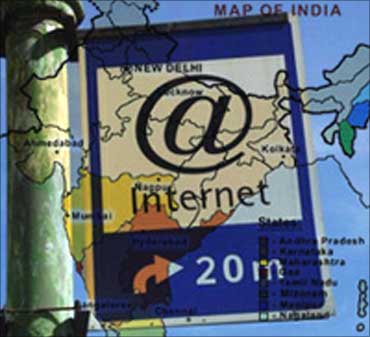Shyamal Majumdar
Vineet Nayyar says the 'incredible' wage push will make India's information technology and information technology-enabled services industry uncompetitive.
The Tech Mahindra vice-chairman and MD also says it will soon be cheaper to hire in certain locations abroad because there will be no economic rationale to hire here.
Calculations made by the Business Standard Research Bureau shows that Nayyar's concerns are not misplaced.
The wage cost of the top-10 IT companies in India has grown by an average17 per cent over the last three years, more than the 10-12 per cent growth in most other industries.
A job portal for MBA students -- iimjobs.com -- has also shown that salaries grew fastest at 12.7 per cent for professionals in the IT sector, taking them closer to their group mates working in finance and consulting.
. . .
Why is IT industry in a wage trap
The average salary for MBAs working in IT divisions was Rs 12.9 lakh (Rs 1.29 million) for three to four years of experience and Rs 17.3 lakh (Rs 1.73 million) for five to seven years of experience.
The trend will only increase since companies are forced to go in for huge hiring plans partly because of the huge attrition rate (60 per cent in the business process outsourcing industry alone).
TCS and Infosys, for example, have said they will hire 30,000 people this year.
It's tempting to dismiss Nayyar's concerns as an exaggeration.
After all, despite a steep increase in wages, India still offers significant labour cost savings.
. . .
Why is IT industry in a wage trap
Starting salaries of graduates in India are still 80-85 per cent lower than in developed countries.
Even with a low average employability of 10-15 per cent for graduates in general and 25 per cent for IT and engineering graduates, India contributes half the current employed global sourcing talent pool.
There is more.
As much as 80 per cent of top companies that are globally sourcing have a centre in India or have a contract with an Indian provider.
All this is good news.
But a Nasscom-McKinsey study has shown why this advantage can go away soon in an industry whose wage bill is growing too fast and will continue to do so due to the future talent demand and lack of employable manpower.
. . .
Why is IT industry in a wage trap
For example, the technology and business service industry will face a talent shortage of over 2 million people by 2020.
As it is, the average salary at the entry level in the industry is Rs 20,000 compared to Rs 12,000 in, for example, the hotels industry.
Moreover, the industry has to spend a lot on training.
An average company is investing 16 weeks to train one employee.
So the huge attrition rate means a double whammy for these companies: Pay more to a fresh graduate and pay more for training since the rapid increase in job switching has not kept pace with improvement in the skill level.
The emergence of alternative locations is making the situation even more complicated.
. . .
Why is IT industry in a wage trap
Though Mexico and Philippines have already emerged as cost-competitive centres, there are others as well.
Malaysia has positioned itself as a location for high-end knowledge services and Egypt and Morocco are positioning themselves as options for low-cost European language locations.
Several others such as Midwestern US, Brazil and Vietnam are also coming up fast owing to a large pool of low-cost talent, strong government support and robust infrastructure.
. . .
Why is IT industry in a wage trap
For example, the US Midwest can offer up to 25 per cent savings in cost due to salary differentials, training costs and tax incentives, and has a good enough talent pool with around 50,000 new graduates every year.
Many major companies such as Wipro, Firstsource, Genpact and Convergys (which now employs more people in Philippines than in India) and so on are rapidly expanding their presence in the Philippines.
Already, Manila ranks number two for offering effective BPO solutions, second only to Bengaluru.
. . .
Why is IT industry in a wage trap
The UK National Outsourcing Association has awarded Philippines the best outsourcing destination for its BPO sector.
Apart from the rapidly improving infrastructure, what make Philippines more attractive is better skill levels and lower relative wages.
For instance, salaries might be the same in India and Phillipines at the lower level, but a Filipino staffer scores on productivity.
. . .
Why is IT industry in a wage trap
While a worker in India, on an average, is able to handle 80 inbound or outbound calls per day, his or her Filipino counterpart handles over 100, according to industry estimates.
It's time, therefore, for a majority of Indian companies to analyse their productivity and identify areas of potential improvement.
The Nasscom-McKinsey study looked at the basic voice processes across business services and found a wide variation in platform costs, with the top quartile players operating at 46 per cent lower costs than bottom quartile players.
Moreover, top performers are seen to continuously improve their operating costs with time, while the industry average operating performance is seen to decline.
That's a wake-up call for many Indian IT companies.










article